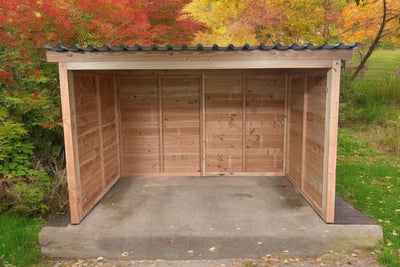Filling a wooden composter: This is how it works

A wooden composter is an excellent choice for sustainable garden maintenance, but filling it correctly is crucial to obtaining high-quality compost. The right mix of materials and their layering are key to a successful composting process.
1. the right mix: green and brown
Successful composting requires a balance of "green" and "brown" materials.
-
Green materials: These consist mainly of nitrogen-rich waste such as fruit and vegetable scraps, freshly cut grass, coffee grounds and tea leaves. They ensure that the compost contains the necessary nutrients and that the decomposition process gets underway.
-
Brown materials: These include carbon-rich materials such as leaves, twigs, straw, paper and cardboard. These ensure good structure and aeration of the compost, which is crucial to avoid unpleasant odors and promote rapid decomposition.
An optimal ratio is about two parts brown to one part green materials.
2. layering and aeration
The layering of materials in the composter is another important aspect for the success of composting.
-
First layer: Start with a layer of coarse materials such as twigs or straw. This ensures good drainage and air circulation in the lower part of the composter.
-
Alternating layers: Add alternating layers of green and brown materials. Each layer should be about 10 to 15 cm high. Avoid adding too much of one material at a time as this can hinder aeration.
-
Aeration: Regularly turning the compost is important to bring oxygen to all areas. This promotes the activity of microorganisms and accelerates decomposition.
3. moisture content
The moisture content of the compost should be checked regularly.
- Correct measure: The compost should be as moist as a wrung-out sponge. Too much moisture leads to rotting, too little delays decomposition. If the compost is too dry, add a little water. If it is too wet, you can counteract this with additional brown material or by loosening it up.
4. avoid mistakes

To ensure optimum composting, certain materials should be kept out of the composter:
-
No animal products: Meat, bones, dairy products and fish scraps attract pests and can cause unpleasant odors.
-
Avoid oily or fatty foods: These decompose slowly and impair the aeration of the compost.
-
Diseased plant material: Plant residues that are affected by diseases should not be composted, as these diseases can spread further in the compost.
5. the maturing process
The correct filling ultimately leads to a high-quality, mature compost that optimally nourishes your garden soil.
- Waiting: Depending on the material and weather conditions, the maturing process takes several months to a year.
- Control: Check the progress regularly. Mature compost has a crumbly structure, a dark color and smells earthy.
Conclusion
Filling your wood composter correctly is crucial for producing high-quality compost. With the right mix of green and brown materials, good layering and aeration, and the right moisture, you can ensure that the composting process runs efficiently.



